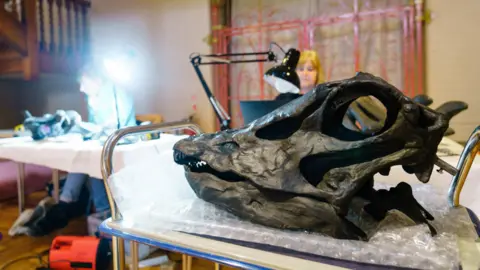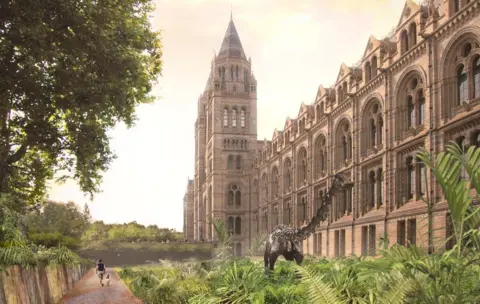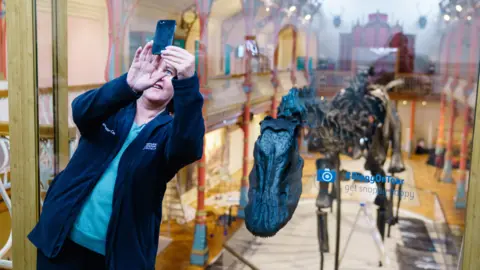Dippy: 'The people's dinosaur' hits the road
Ask people to name museum exhibits in the UK and the chances are that a certain dinosaur will top their list.
Dippy the Diplodocus has a special place in the hearts of so many, probably because it was the first thing they saw as a child when they entered London's Natural History Museum.
It's one of those wow moments that stays with you all of your life. But you can't have missed the news last year that this stop-you-in-your-tracks responsibility has since been passed to a blue whale skeleton.
The cetacean known as Hope now lunges down on young visitors as they come through the doors of the NHM.
Dippy, somewhat controversially, was packed off for a bit of R&R, in Canada of all places.
But the Diplodocus is now back and is ignoring London to head out across the UK. The first stop, until May, is Dorset County Museum in Dorchester.
And having had a sneak preview this week, all I'll say is be prepared to be wowed all over again.
The Victorian hall being used as the exhibition space is tight. It's so tight in fact that sections of iron railing along a balcony at either end of the hall have had to be removed to fit the fossil cast in the building.
That has two effects. The first is to make Dippy look big - very big. Perhaps for the first time ever I now appreciate the true scale of this animal that lived roughly 155 million years ago.
The second thing is you get a perspective on Dippy you've never had before. That balcony I mentioned brings you up to a level where you could almost imagine riding the dinosaur. And at the front end, it means you look directly into Dippy's face.
A perspex screen will stop you touching the skull, but the position will make for the absolute best selfie you'll take this year.
"I was worried," admits Lorraine Cornish, the NHM's head of conservation. "I love this hall and I love Dippy, obviously. But I wasn't sure how they'd come together. In the end, it's turned out to be amazing.
"Dippy fills the space and you get a new sense of awe when you walk in and realise just how long this dinosaur was and also how high."
Dippy's been cleaned and mounted on a new support frame made in Canada (the reason for that foreign excursion), but the posture is exactly the same as that displayed back in the NHM.
The only significant change is the introduction of anatomically correct hands at the front of the animal. Previously, the dinosaur had two sets of back feet!
Dorset County Museum is the first of eight stops that take in all four home nations. Next up will be:
- Birmingham Museum & Art Gallery - Birmingham
- Ulster Museum - Belfast
- Kelvingrove Art Gallery and Museum - Glasgow
- Great North Museum: Hancock – Newcastle upon Tyne
- National Assembly for Wales - Cardiff
- Number One Riverside - Rochdale
- Norwich Cathedral – Norwich
 NHM
NHMFor the Dorset museum's director, Jon Murden, hosting Britain's favourite dinosaur is an extraordinary honour.
"I'm really glad it fits in the building; it's certainly been a challenge," he says. "We had to pitch for this, of course. We had to show we were credible and professional, and that we had a partnership to deliver the overall objectives which are about inspiring the next generation of scientists and speaking to the theme of evolution."
But Dr Murden believes also that his venue was simply the most obvious place in the country for Dippy to come. And that's explained if you make the short drive from Dorchester to Osmington Mills on the coast - the famous "Jurassic Coast" recognised now as a World Heritage Site by Unesco for its extraordinary sequence of exposed rock covering some 185 million years of Earth history.
"Dippy lived in the wetlands of North America around where Wyoming is," explains Sam Scriven from the Jurassic Coast Trust, as we walk along the beach.
"If you travel back to the same time [in Osmington Mills], you'd be swimming in a fairly deep tropical sea where there were different sorts of giants - things like giant pliosaurs which were these enormous marine reptiles, predators, that were just as terrifying as T. rex."
It was out of the Kimmeridge Clay cliffs at Osmington Mills that the fossil remains of Pliosaurus kevani emerged - possibly the largest marine reptile that ever lived. Its story, told daily at Dorset County Museum, will now be complemented by that of Dippy. But hurry. It's timed-tickets only and the one-hour slots are already going fast.
Dippy will eventually return to London. The NHM says it is open-minded about a long-term home for the Diplodocus but emphasises that the cast will always remain a part of the national collection.
My favoured idea remains the one floated a few years back which is to re-make the people's favourite in bronze and put it in the front gardens of the South Kensington institution.
Most of the original moulds exist, so it would be possible. It would cost a pretty penny, though. But the reaction to the Dippy tour, I venture, will show that public support for such a proposal would be very strong.
 NIALL MCLAUGHLIN ARCHITECTS
NIALL MCLAUGHLIN ARCHITECTS NHM
NHM